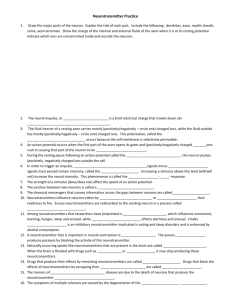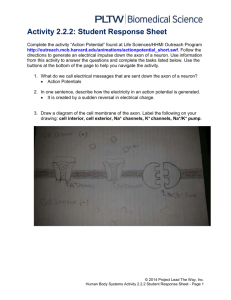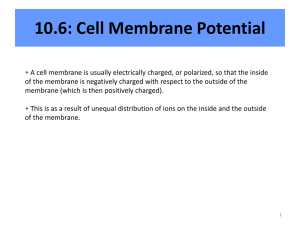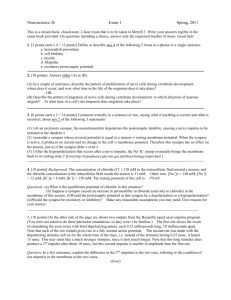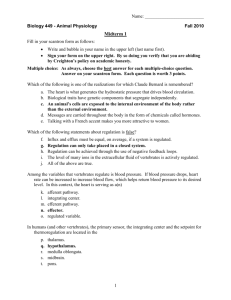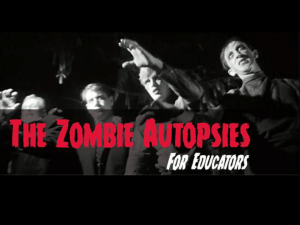neurophysiology lecture - Sinoe Medical Association
advertisement
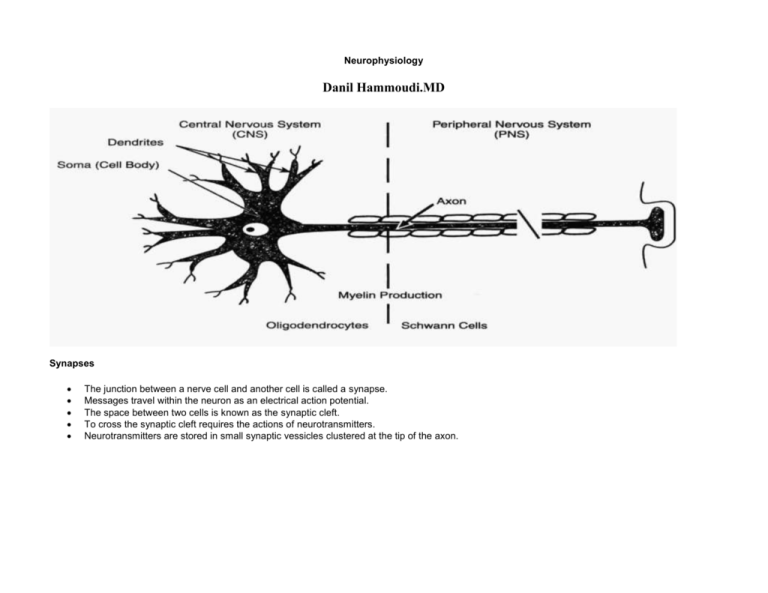
Neurophysiology Danil Hammoudi.MD Synapses The junction between a nerve cell and another cell is called a synapse. Messages travel within the neuron as an electrical action potential. The space between two cells is known as the synaptic cleft. To cross the synaptic cleft requires the actions of neurotransmitters. Neurotransmitters are stored in small synaptic vessicles clustered at the tip of the axon. Types of synapse l Axosomatic: to the neuron's body. 2 Axodendritic: e.g., from climbing fibres to Purkinje cells' dendrites. 3 Axodendritic to spines, e.g., from parallel fibres to Purkinje cells' dendritic spines. (The presence of spines on dendrites is used to subclassify neurons in many brain regions.) 4 Glomerular: a rounded structure serving several dendrites, e.g., from mossy fibres to cerebellar granule neurons. 5 En passant: made 'in passing' on the way to other synapses. 6 Axo-axonic: synapse onto another synapse or the axon's initial segment (for presynaptic inhibition). 7 Reciprocal dendro-dendritic: e.g., in retina and olfactory bulb. 2 Synapses also differ in the number, size and density of their vesicles, in the transmitter and neuromodulator substances that these hold, in the organelles present, and in the cleft material and membrane densities. 3 Chemical neuroanatomy involves mapping which connections of the CNS employ particular neurotransmitters, e.g., serotonin, acetylcholine, dopamine, etc Axodendritic Synapse Axosomatic Synapse Axoaxonic Synapse Synapses and neuromuscular junctions = motor end plates; unidirectional but may be stimulatory or inhitibory; site of intercommunication btwn adjacent neurons main types of synapses axosodendritic axosomatic axoaxonic anatomy of synapse terminal bouton: not myelinated; contain mitochondria etc. o synaptic vesicle: about 50 nm in diameter; derived from sER dense-cored vesicles: autonomic synapses o presynaptic membrane: release contents of presynaptic vesicles upon arrival of action potential synaptic cleft (20 to 30 nm): uniform thickness; neurotransmitter diffuse across; contain hydrolytic and oxidative enzymes which inactivate released neurotransmitters; postsynaptic membrane receptors postsynaptic web neurotransmitters: chemical transmitter substances initiate action potential in adjacent neuron or effector organ CNS: many types PNS: 2 types acetylcholine: neurotransmitter of somatic neuromuscular junctions; neurotransmitter of all preganglionic fibers in autonomic nervous system; main neurotransmitter of postganglionic parasympathetic neurons noradrenaline (norepinephrine): main neurotransmitter of postganglionic sympathetic neurons (except sweat glands) Arrival of the action potential causes some of the vesicles to move to the end of the axon and discharge their contents into the synaptic cleft. Released neurotransmitters diffuse across the cleft, and bind to receptors on the other cell's membrane, causing ion channels on that cell to open. Some neurotransmitters cause an action potential, others are inhibitory. Neurotransmitters tend to be small molecules, some are even hormones. The time for neurotransmitter action is between 0,5 and 1 millisecond. Neurotransmitters are either destroyed by specific enzymes in the synaptic cleft, diffuse out of the cleft, or are reabsorbed by the cell. More than 30 organic molecules are thought to act as neurotransmitters. The neurotransmitters cross the cleft, binding to receptor molecules on the next cell, prompting transmission of the message along that cell's membrane. Acetylcholine is an example of a neurotransmitter, as is norepinephrine, although each acts in different responses. Once in the cleft, neurotransmitters are active for only a short time. Enzymes in the cleft inactivate the neurotransmitters. Inactivated neurotransmitters are taken back into the axon and recycled. Diseases that affect the function of signal transmission can have serious consequences. Parkinson's disease has a deficiency of the neurotransmitter dopamine. Progressive death of brain cells increases this deficit, causing tremors, rigidity and unstable posture. L-dopa is a chemical related to dopamine that eases some of the symptoms (by acting as a substitute neurotransmitter) but cannot reverse the progression of the disease. The bacterium Clostridium tetani produces a toxin that prevents the release of GABA. GABA is important in control of skeletal muscles. Without this control chemical, regulation of muscle contraction is lost; it can be fatal when it effects the muscles used in breathing. Clostridium botulinum produces a toxin found in improperly canned foods. This toxin causes the progressive relaxation of muscles, and can be fatal. A wide range of drugs also operate in the synapses: cocaine, LSD, caffeine, and insecticides. Action Potential The action potential is an electrical phenomenon that occurs in nerve cells (or neurons). It is a self-propagating event that begins at a dendrite and travels down the axon to the end of the neuron. Phases of the Action Potential • 1 – resting state • 2 – depolarization phase • 3 – repolarization phase • 4– hyperpolarization Absolute and Relative Refractory Periods Figure 11.15 The neuron starts at resting membrane potential which is around -70 mv (inside of the neuron is negative compared to outside). When the neuron is stimulated (say, by pressure), a little bit of Na+ spills into the neuron through leak channels. The entry of Na+ depolarizes the neuron and is referred to as a graded potential. If enough Na+ enters, the inside of the membrane becomes positive enough to reach threshold potential. If this happens, voltage-gated Na+ channels open allowing a large influx (entry) of Na+ into the neuron. As Na+ enters, the membrane potential becomes increasingly more positive. This causes the upstroke of the action potential. After a millisecond or so, the voltage-gated Na+ channels close and voltage-gated K+ channels open allowing K+ to leave the neuron (efflux). As K+ leaves, the loss of positive charge causes the downstroke of the action potential. The membrane potential briefly goes more negative than normal causing a hyperpolarization. Then the Na+/K+ pump kicks in and restores resting membrane potential and the action potential is finished. So, the action potential is called a brief reversal of membrane potential because it starts at about -70 mv, goes up to around +30 mv, and back to -70 mv. This is the nerve impulse that travels along your nerves or neurons. It can travel hundreds of metres per second! Neurotransmitters Chemicals used for neuronal communication with the body and the brain 50 different neurotransmitters have been identified Classified chemically and functionally Neurotransmitters Acetylcholine (AcH) Dopamine (DA) Histamine Norepinephrine (NE) Epinephrine Serotonin (5-HT) Peptides Gamma-Aminobutyric Acid (GABA) Glutamate Aspartate Glycine Neuropeptides (there are more neuropeptides; to find out visit www.faculty.washington.edu/chudler/) Insulin Beta-endorphin Neuropeptide Y Calcitonin Chemical Neurotransmitters Acetylcholine (ACh) Biogenic amines Amino acids Peptides Novel messengers: ATP and dissolved gases NO and CO Neurotransmitters: Acetylcholine First neurotransmitter identified, and best understood Released at the neuromuscular junction Synthesized and enclosed in synaptic vesicles Degraded by the enzyme acetylcholinesterase (AChE) Released by: All neurons that stimulate skeletal muscle Some neurons in the autonomic nervous system Neurotransmitters: Biogenic Amines Include: Catecholamines – dopamine, norepinephrine (NE), and epinephrine Indolamines – serotonin and histamine Broadly distributed in the brain Play roles in emotional behaviors and our biological clock Synthesis of Catecholamines Enzymes present in the cell determine length of biosynthetic pathway Norepinephrine and dopamine are synthesized in axonal terminals Epinephrine is released by the adrenal medulla Neurotransmitters: Amino Acids Include: GABA – Gamma ()-aminobutyric acid Glycine Aspartate Glutamate Found only in the CNS Neurotransmitters: Peptides Include: Substance P – mediator of pain signals Beta endorphin, dynorphin, and enkephalins Act as natural opiates; reduce pain perception Bind to the same receptors as opiates and morphine Gut-brain peptides – somatostatin, and cholecystokinin Neurotransmitters: Novel Messengers ATP Is found in both the CNS and PNS Produces excitatory or inhibitory responses depending on receptor type Induces Ca2+ wave propagation in astrocytes Provokes pain sensation Nitric oxide (NO) Activates the intracellular receptor guanylyl cyclase Is involved in learning and memory Carbon monoxide (CO) is a main regulator of cGMP in the brain Functional Classification of Neurotransmitters Two classifications: excitatory and inhibitory Excitatory neurotransmitters cause depolarizations (e.g., glutamate) Inhibitory neurotransmitters cause hyperpolarizations (e.g., GABA and glycine) Some neurotransmitters have both excitatory and inhibitory effects Determined by the receptor type of the postsynaptic neuron Example: acetylcholine Excitatory at neuromuscular junctions with skeletal muscle Inhibitory in cardiac muscle Neurotransmitter Receptor Mechanisms Direct: neurotransmitters that open ion channels Promote rapid responses Examples: ACh and amino acids Neural Integration: Neuronal Pools Functional groups of neurons that: Integrate incoming information Forward the processed information to its appropriate destination Simple neuronal pool Input fiber – presynaptic fiber Discharge zone – neurons most closely Indirect: neurotransmitters that act through second messengers Promote long-lasting effects Examples: biogenic amines, peptides, and dissolved gases Channel Linked Receptors Composed of integral membrane protein Mediate direct neurotransmitter action Action is immediate, brief, simple, and highly localized Ligand binds the receptor, and ions enter the cells Excitatory receptors depolarize membranes Inhibitory receptors hyperpolarize membranes G Protein Linked Receptors Responses are indirect, slow, complex, prolonged, and often diffuse These receptors are transmembrane protein complexes Examples: muscarinic ACh receptors, neuropeptides, and those that bind biogenic amines G Protein-Linked Receptors: Mechanism Neurotransmitter binds to G protein-linked receptor G protein is activated and GTP is hydrolyzed to GDP The activated G protein complex activates adenylate cyclase Adenylate cyclase catalyzes the formation of cAMP from ATP cAMP, a second messenger, brings about various cellular responses G Protein-Linked Receptors: Effects G protein-linked receptors activate intracellular second messengers including Ca2+, cGMP, diacylglycerol, as well as cAMP Second messengers: Open or close ion channels Activate kinase enzymes Phosphorylate channel proteins Activate genes and induce protein synthesis associated with the incoming fiber Facilitated zone – neurons farther away from incoming fiber Types of Circuits in Neuronal Pools Divergent – one incoming fiber stimulates ever increasing number of fibers, often amplifying circuits Types of Circuits in Neuronal Pools Convergent – opposite of divergent circuits, resulting in either strong stimulation or inhibition Reverberating – chain of neurons containing collateral synapses with previous neurons in the chain Parallel after-discharge – incoming neurons stimulate several neurons in parallel arrays Patterns of Neural Processing Serial Processing Input travels along one pathway to a specific destination Works in an all-or-none manner Example: spinal reflexes Parallel Processing Input travels along several pathways Pathways are integrated in different CNS systems One stimulus promotes numerous responses Example: a smell may remind one of the odor and associated experiences The Nerve Message | The plasma membrane of neurons, like all other cells, has an unequal distribution of ions and electrical charges between the two sides of the membrane. The outside of the membrane has a positive charge, inside has a negative charge. This charge difference is a resting potential and is measured in millivolts. Passage of ions across the cell membrane passes the electrical charge along the cell. The voltage potential is -65mV (millivolts) of a cell at rest (resting potential). Resting potential results from differences between sodium and potassium positively charged ions and negatively charged ions in the cytoplasm. Sodium ions are more concentrated outside the membrane, while potassium ions are more concentrated inside the membrane. This imbalance is maintained by the active transport of ions to reset the membrane known as the sodium potassium pump. The sodium-potassium pump maintains this unequal concentration by actively transporting ions against their concentration gradients. Eventually enough potassium ions pass to the outside to restore the membrane charges to those of the original resting potential. The cell begins then to pump the ions back to their original sides of the membrane. The action potential begins at one spot on the membrane, but spreads to adjacent areas of the membrane, propagating the message along the length of the cell membrane. After passage of the action potential, there is a brief period, the refractory period, during which the membrane cannot be stimulated. This prevents the message from being transmitted backward along the membrane. Steps in an Action Potential 1. At rest the outside of the membrane is more positive than the inside. 2. Sodium moves inside the cell causing an action potential, the influx of positive sodium ions makes the inside of the membrane more positive than the outside. 3. Potassium ions flow out of the cell, restoring the resting potential net charges. 4. Sodium ions are pumped out of the cell and potassium ions are pumped into the cell, restoring the original distribution of ions. I. REVIEW MEMBRANE POTENTIAL Changed polarity of the membrane, the action potential, results in propagation of the nerve impulse along the membrane. An action potential is a temporary reversal of the electrical potential along the membrane for a few milliseconds. Sodium gates and potassium gates open in the membrane to allow their respective ions to cross. Sodium and potassium ions reverse positions by passing through membrane protein channel gates that can be opened or closed to control ion passage. Sodium crosses first. At the height of the membrane potential reversal, potassium channels open to allow potassium ions to pass to the outside of the membrane. Potassium crosses second, resulting in changed ionic distributions, which must be reset by the continuously running sodiumpotassium pump. A. Biophysical properties determine ion distribution 1. Na+ outside, K+ inside, Anion- inside B. Resting membrane is negative inside-positive outside C. Passive ion flow is much more important than the ATPase pump D. Changes in ion permeability alters membrane potential 1. Goldman Equation revisited 2. Change in the permeability for a number of ions affects resting potential II. CHANGES IN MEMBRANE POTENTIAL A. Graded Potentials 1. Hyperpolarizing stimulus verses depolarizing stimulus 2. Stimulus strength 3. No refractory period 4. Passive current spread a. Passive current deteriorates with distance B. Action Potential (=nerve impulse) 1. Characteristics of the Action Potential (AP) a. At threshold firing is all-or-none b. Refractory period present III. ACTION POTENTIAL: ELECTRICAL CHARACTERISTICS 1. degradation (recycling), reuptake (e.g., Zoloft), etc. 2. Drugs alter neurotransmitter function in a number of ways. A. Selective Na+ conductance followed by K+ conductance 1. Positive feedback for Na+ 2. Voltage change affects ion gating (=voltage-dependent gates) 3. Roles of Na+ and K+ flux in the action potential (Animation) 4. Role of the Na+/K+ ATPase pump at reestablishing ion gradients B. Refractory period 1. Significance of the refractory period a. Absolute refractory period b. Relative refractory period C. Movement of the AP along the axon 1. Neuronal structure 2. Why does the AP start at the axon hillock? 3. AP propogation down the axon D. Saltatory Conduction 1. The myelin sheath (Schwann cell) and the nodes 2. Passive current spread (Animation) a. Multiple Sclerosis (MS) 3. Axon diameter also influences speed of conduction IV. SYNAPSES Electrical Synapses Electrical synapses: Are less common than chemical synapses Correspond to gap junctions found in other cell types Are important in the CNS in: Arousal from sleep Mental attention Emotions and memory Ion and water homeostasis Chemical Synapses Specialized for the release and reception of A. Electrical Synapse 1. Structure of the gap junction 2. Electrical properties neurotransmitters Typically composed of two parts: Axonal terminal of the presynaptic neuron, which contains synaptic vesicles B. Chemical Synapse: Acetylcholine as an example 1. General structure of the chemical synapse 2. Mechanism of neurotransmitter loading and release a. Transporting vesicles to the terminal b. Loading synaptic vesicles within the terminal c. Docking and vesicle exocytosis 3. Summary (Animation) C. Neurotransmitter action 1. Changes at the post-synaptic membrane 2. Post-synaptic effect of neurotransmitter a. Nicotinic Ach receptor excites skeletal muscle 1) Na+/K+ channel opens on the postsynaptic membrane D. What are the fates of secreted neurotransmitter? Receptor region on the dendrite(s) or soma of the postsynaptic neuron Synaptic Cleft Fluid-filled space separating the presynaptic and postsynaptic neurons Prevents nerve impulses from directly passing from one neuron to the next Transmission across the synaptic cleft: Is a chemical event (as opposed to an electrical one) Ensures unidirectional communication between neurons -Synaptic Cleft: Information Transfer Nerve impulses reach the axonal terminal of the presynaptic neuron and open Ca2+ channels Neurotransmitter is released into the synaptic cleft via exocytosis in response to synaptotagmin Neurotransmitter crosses the synaptic cleft and binds to receptors on the postsynaptic neuron Postsynaptic membrane permeability changes, causing an excitatory or inhibitory effect EPSPs must summate temporally or spatially to induce an action potential Temporal summation – presynaptic neurons transmit impulses in rapid-fire order -Termination of Neurotransmitter Effects Neurotransmitter bound to a postsynaptic neuron: Produces a continuous postsynaptic effect Blocks reception of additional “messages” Must be removed from its receptor Removal of neurotransmitters occurs when they: Are degraded by enzymes Are reabsorbed by astrocytes or the presynaptic terminals Diffuse from the synaptic cleft Synaptic Delay Spatial summation – postsynaptic neuron is stimulated by a large number of terminals at the same time IPSPs can also summate with EPSPs, canceling each other out ACTION POTENTIAL : LOOK AT THIS LINK FOR ANIMATION http://www.blackwellpublishing.com/matthews/ch annel.html Neurotransmitter must be released, diffuse across the synapse, and bind to receptors Synaptic delay – time needed to do this (0.3-5.0 ms) Synaptic delay is the rate-limiting step of neural transmission Postsynaptic Potentials Neurotransmitter receptors mediate changes in membrane potential according to: The amount of neurotransmitter released The amount of time the neurotransmitter is bound to receptors The two types of postsynaptic potentials are: EPSP – excitatory postsynaptic potentials IPSP – inhibitory postsynaptic potentials Excitatory Postsynaptic Potentials(EPSP) EPSPs are graded potentials that can initiate an action potential in an axon Use only chemically gated channels Na+ and K+ flow in opposite directions at the same time Postsynaptic membranes do not generate action potentials http://www.blackwellpublishing.com/matthews/an imate.html . Resting potential: At rest the neuron is like a tiny battery with a resting potential of about-70 millivolts 1. selectively permeable membrane: 2. the fluid both inside and outside of the axon contains ions. A. organic anions (A-): trapped inside the cell at all times. B. sodium (Na+): Na+ stays primarily on the outside of the cell a. voltage gated channel exist for Na+ C. potassium (K+): these cross the cell membrane more easily & are found mostly inside the cell. a. voltage gated channels exist for K+ D. Chloride anions (Cl-) are concentrated mostly outside of the cell. a. voltage gated ion channels exist for Clb. Cl- does not contribute to the resting potential E. calcium (Ca+) concentrated mostly outside the neuron a. voltage gated ion channels exist for Ca+ Inhibitory Synapses and IPSPs Neurotransmitter binding to a receptor at inhibitory synapses: Causes the membrane to become more permeable to potassium and chloride ions Leaves the charge on the inner surface negative Reduces the postsynaptic neuron’s ability to produce an action potential Summation A single EPSP cannot induce an action potential II. Action potential (firing of a neuron): the ion exchange 1. voltage dependent Na+ channels in the cell membrane open 2. Na+ entering causes the cell internal environment to become depolarized 3. drop in voltage causes K+ channels to open and K+ to pour out of the cell. 4. The Na+ channels then close but K+ con’t to pour out 5. this causes the membrane potential to begin to drop 6. The ions then diffuse away from the membrane III. Action potential (AP): definition & other facts 1. action potential: is a brief change in the neuron's electrical charge. 2. certain drugs like Novocain inhibit action potentials 3. they are all or none: 4. The AP skips from one node of Ranvier to another 5. APs cause the release of chemicals from terminal buttons (Kingsley p.109) A. Neurotransmitters: influence cells located a very short distance away. B. neuromodulators: (paracrine) travel further C. Hormones: absorbed into the blood, and travel thru the blood stream. IV. Refractory period 1. absolute refractory period: no stimulus will elicit an action potential 2. relative refractory period: stronger stimulus is necessary V. sodium-potassium pump: push the Na+ back out & K+ back in. VI. the synapse or synaptic cleft: space between the terminal buttons and the membrane of another cell. 1. synaptic cleft is about 200 A wide (1 ten millionth of a millimeter). VII. neurotransmitter (NT) storage 1. Synaptic vesicles (SV): are small round pockets that contain NT A. formed by invaginations of synaptic bouton 2. secretory vesicles: membrane bound pockets that contain peptides A. these vesicles come from the Golgi apparatus VIII. synaptic transmission (referring to synaptic vesicles (SV)) Presynaptic neuron: 1. APs cause SV to migrate to the presynaptic membrane (docking process), 2. Ca+ channels open when depolarized by an action potential. 3. calcium causes SV membrane to fuse with the presynaptic membrane A. NT then pours into the synapse.. B. SV membrane is then pinched off (pinocytosis) & recycled postsynaptic neuron: 1. NT attach to parts of the postsynapse (i.e., receptors) A. The ligand fits into a binding site like a key fits into a lock. 2. Ligand binding causes ion channels to open. 2 types of receptors exist A. ionotropic receptors (ligang gated): B. metabotropic receptors (G-protein linked) IX. Postsynaptic potentials: 1. types (EPSPs & IPSPs) A. Excitatory postsynaptic potential (EPSP) are depolarizations that make The postsynaptic neuron more likely to fire B. Inhibitory postsynaptic potentials (IPSP) are caused by hyperpolarization and inhibit APs. 2. Postsynaptic potentials (PSPs): other facts A. EPSPs and IPSPs are additive a. temporal summation & spatial summation. B. PSPs: are variable C. Threshold: sufficient EPSPs to raise the membrane potential above a certain level at the initial segment of the axon, is so an AP will occur D. proximal inhibitory synapses have a greater influence 3. How do postsynaptic potentials occur? A. Some NT are exclusively inhibitory others excitatory B. most NT can produce either effect depending on the receptor. 4. Types of ligand dependent channels A. NT causes ligand gated ion channels to open B. There are 4 primary types of NT (ligand) dependent ion channels a. Na+ channels: b. K+ channels: c. Cl- channels: d. Ca+ channels: X. How is the NT signal regulated? 1. NT signals must be terminated A. Reuptake: where NT is taken back into the presynaptic cell. B. Enzymatic deactivation refers to the breakdown of NT C. NT also diffuses out of the synapse 2.Autoreceptors: are found on the presynaptic neuron and are thought to regulate internal processes 3. axoaxonic synapse: These alter the amount of NT released by the terminal button. (Called presynaptic inhibition] A. They usually are inhibitory. Types of NT I. Acetylcholine (ACh) 1. this NT has 2 types of receptors A. nicotinic receptors: a. agonist: is nicotine b. antagonist: is curare B. muscarinic receptors: a. agonist: is muscarine b. antagonist: in atropine (deadly nightshade 2. deactivated by acetylcholinesterase (AChE) & choline is reused 3. physostigmine: inhibits AChE (agonist) but is reversible. 4. botulinum toxin prevents the release of ACH from the terminal button (antagonist) 5. black widow spider venom causes ACH terminals to release ACH (agonist) Monoamines A. works at the same receptors as NE B. stimulates the sympathetic nervous system C. ephedrine: alpha & beta receptor agonist D. propranolol: beta receptor blocker has antihypertensive effects 3 Dopamine (DA) A. produced in substantia nigra & ventral tegmental area (midbrain) & sent to the cortex, limbic system, hypothalamus, & basal ganglia B. implicated in movement disorders e.g., in Parkinson's disease (L-DOPA) C. cocaine and amphetamine work by preventing reuptake D. apomorphine: stimulates only autoreceptors (an antagonist) Amino Acid Transmitters: I. gamma aminobutyric acid (GABA) 1. is produced from glutamic acid (glutamate) 2. an inhibitory neurotransmitter II. glutamic acid (glutamate): 1. the principal excitatory NT in the brain 2. phencyclidine (PCP) may have its effects by influencing this NT All monoamines work thru metabotropic receptors Monoamine oxidase (MAO) & catechol-Omethyltransferase (COMT) deactivate these. 1. The drug reserpine prevents the storage of the monoamines III. glycine: 1. an inhibitory NT found in the brain stem & spinal cord 2. tetanus bacteria blocks the activity of this NT Peptide Transmitters: types of monoamines: I. Indolamines: Peptide Transmitters: some terminal buttons release both classical NT & peptide NT at once, 1. Serotonin (5-HT) A. produced in the raphe nuclei in the midline of the pons & medulla (p. 133 Kingsley) B. the drug parachlorophenylalanine (PCPA) blocks tryptophan hydroxylase & prevents the synthesis of 5-HT (an antagonist) C. iproniazid block MAO (agonists) I. Endorphins (16-30 amino acids) or enkephalins (shorter chains of amino acids). These are endogenous opiates 1. 3 types of receptors have been found (mu, kappa, & sigma). 2. all opiate drugs are endorphin agonists II. anandamides: a natural ligand similar to THC 1. receptors have been found for these chemicals II. Catecholamines: III. substance P: increases perceptions of pain The amino acid tyrosine is the precursor NT is released thru axononal varicosities: swellings on the axon 1. Norepinephrine (NE) noradrenalin A. in the CNS this is produced in the locus ceruleus (nucleus in midbrain) & is distributed though out the CNS 2. Epinephrine (E) adrenaline Soluble gases: I. Nitric oxide 1. Kingsley suggest that this gas may be involved in learning V. INTEGRATION OF POSTSYNAPTIC POTENTIALS (EPSP/IPSP) A. Excititory and inhibitory synapses B. How integration of multiple inputs is achieved. 1. Postsynaptic response a. Spatial and temporal summation b. Cancellation of a EPSP by a IPSP 2. Presynaptic inhibition and facilitation C. Convergence and divergence in neuronal pathways D. Summary: Physiology of the synapse VI. NEUROTRANSMITTERS AND NEUROPEPTIDES A. "Classical" Neurotransmitters B. Two important points about neurotransmitters 1. Action of multiple neurotransmitters permits homeostatic processing 2. The effect of a neurotransmitter (=messenger) is always specific for a target tissue a. Example: Ach generates different responses in target cells C. Neuropeptides are neuromodulators 1. Characteristics of neuropeptides 2. Neuropeptides resemble neurotransmitters in some ways a. Example of how neurotransmitters and neuropeptides interact (Animation involving Substance P, GABA, and Glutamate) VII. INTERCELLULAR COMMUNICATION A. Types of intercellular communication: Paracrine, nervous, endocrine, and neuroendocrine systems B. Comparison of the nervous and endocrine actions VIII. PRINCIPLES OF HORMONE COMMUNICATION A. Characteristics of hormones/neurohormones 1. Three types of hormones (peptides, amines, steroids) a. Neurohormones are always peptides 2. Summary of hydrophilic verses lipophilic hormones a. Chemical structure b. Hormone transport c. Hormone synthesis d. Hormone secretion 3. Hormone action at the target cell a. General characteristics of hormone action b. Peptide and Epinephrine action: Mechanism (Animation) 1) Involves a second messenger (e.g., cAMP or Ca++) c. Steroid and Thyroxine action: Mechanism (Animation) d. Amplification of the signal 4. Fate of hormones IX. INTRODUCTION TO RECEPTOR PHYSIOLOGY How receptors work 1. Law of mass action 2. Drugs can act as agonists and antagonists a. Competitive and noncompetitive effects To resume NERVE IMPULSES 1. The Italian scientist Luigi Galvani found that nervous tissue (groups of cells that conduct impulses) displays Electrical Activity in the form of a Nerve Impulse, which is a flow of electrical charges along The Cell Membranes of a Neuron. 2. This Electrical Activity is due to Movement of IONS (charge particles) across the Cell Membrane. SODIUM - Na+, AND POTASSIUM - K+. 3. The movement of these Ions is affected by their ability to pass through the Cell membrane, their Concentration Inside and Out of the Cell, and Their Charge. 4. Neurons have an Electrical Charge Different from the Extracellular Fluid that surrounds them. A difference in electrical Charge between Two Locations is called a POTENTIAL. RESTING POTENTIAL 1. A Nerve Cell has ELECTRICAL POTENTIAL across its cell membrane because of a difference in the number of Positively and Negatively Charged IONS on each side of the Cell Membrane. 2. The Electrical Potential is due to PROTEINS in the Neuron known as SodiumPotassium Pumps move Sodium ions (Na+) OUT of the Cell and Actively Pump Potassium ions (K+) INTO the Cell. 3. The result of this Active Transport of ions is the Cytoplasm of the neuron contains MORE K+ IONS and FEWER Na+ IONS than the surrounding medium. 4. The Cytoplasm also contains Many NEGATIVE CHARGES PROTEINS Molecules and Ions. 5. K+ ions can leak out across the membrane more easily than Na+ ions can leak in. 6. The Negatively charged protein molecules and ions do not leak in or out. 7. The Net Result of the leakage of positively charged ions out of the cell is a Negative Charge on the INSIDE of the neuron's Cell Membrane. 8. The Charge Difference is known as the RESTING POTENTIAL of the Neuron's Cell Membrane. 9. As a result of its Resting Potential, the Neuron is said to be POLARIZED. 10. POLARIZED = Negatively Charged on the inside of the Cell Membrane, and Positively Charged on the Outside. 11. A Neuron maintains this polarization until it is stimulated. 12. A STIMULUS is a change in the environment that may be of sufficient strength to initiate an impulse. 13. The ability of a neuron to respond to a Stimulus and Convert it into a nerve impulse is known as EXCITABILITY. THE MOVING IMPULSE 1. A Nerve Impulse causes a movement of ions across the cell membrane of a neuron… Similar to a ripple passing along the surface of a pond. 2. The cell membrane of a neuron contains thousands of tiny molecules known as GATES. (Sodium and Potassium) 3. These Gates allow either Sodium or Potassium ions to pass through. 4. Generally the Gates on a neuron are CLOSED. 5. A Nerve Impulse STARTS when Pressure or other Sensory Inputs, Disturbs a Neuron's Plasma Membrane, causing Sodium Gates to OPEN. 6. At the beginning of an impulse, the Sodium Gates OPEN, allowing positively charged Na+ ions to flow INSIDE the Cell Membrane. 7. The INSIDE of the membrane temporarily becomes MORE POSITIVE than the OUTSIDE. THIS IS CALLED DEPOLARIZED . 8. The Membrane is now said to be DEPOLARIZED: the charge inside the axon changes from negative to positive as sodium ions enter the interior. 9. As the impulse passes, the Potassium Gates OPEN, allowing positively charged K+ ions to FLOW OUT. REPOLARIZED: the inside of the axon resumes a negative charge. 10. The membrane is now said to be REPOLARIZED. Once again NEGATIVELY Charged on the INSIDE and POSITIVELY Charged on the OUTSIDE. 11. The DEPOLARIZATION and REPOLARIZATION of a Neuron Membrane is called an ACTION POTENTIAL. Action Potential is another name for a Nerve Impulse or simply an impulse. 12. After a nerve impulse is period when the neuron is unable to conduct a nerve impulse called the REFRACTORY PERIOD. 14. The Refractory Period is a very short period during which the sodium-potassium pump continues to return sodium ions to the outside and potassium ions to the inside of the axon. THUS RETURNING THE NEURON TO RESTING POTENTIAL. 15. An impulse is not an electric current; it is a wave of Depolarization and Repolarization. Or a nerve impulse is actually the movement of an action potential along a neuron as a series of voltage-gated ions channels open and close. 16. An impulse is much SLOWER than an electric current. 17. Unlike an electric current, the STRENGTH of an impulse is ALWAYS the SAME. 18. There is either an impulse to a stimulus or there in not. (ALL OR NOTHING) PROPAGATION 1. An impulse is self-propagating. Once started it continues, and moves only in one direction. Like the falling of Dominos. MYELIN SHEATH 1. Myelin Sheaths greatly increase the speed of impulse along an axon. 2. Myelin is composed of 80% lipid and 20% protein. 3. Myelin is made of special cells called Schwann Cells that forms an insulated sheath, or wrapping around the axon. 4. There are SMALL NODES or GAPS called the Nodes of Ranvier between adjacent myelin sheath cells along the axon. 5. As an impulse moves down a myelinated (covered with myelin) axon, the impulse JUMPS form Node to Node instead of moving along the membrane. 6. This jumping from Node to Node greatly increase the speed of the impulse. 7. Some myelinated axons conduct impulses as rapid as 200 meters per second. 8. The formation of myelin around axons can be thought of as a crucial event in evolution of vertebrates. 9. Destruction of large patches of Myelin characterize a disease called Multiple Sclerosis. In multiple sclerosis, small, hard plaques appear throughout the myelin. Normal nerve function is impaired, causing symptoms such as double vision, muscular weakness, loss of memory, and paralysis. THE THRESHOLD 1. The Strength of an impulse is always the SAME. 2. Either there is an impulse in response to a STIMULUS or there is not. 3. A STIMULUS must be of Adequate Strength to cause a neuron to conduct an impulse. 4. The MINIMUM LEVEL of a STIMULUS that is REQUIRED to Activate a neuron is called the THRESHOLD. 5. Any Stimulus WEAKER than the Threshold will produce NO impulse. 6. Any Stimulus STRONGER than the Threshold WILL produce an impulse. 7. A nerve impulse follows the ALL-OR-NONE Principle. COMMUNICATION BETWEEN NEURONS CROSSING THE SYNAPTIC CLEFT OR SYNAPSE 1. The Axon ends with many small swellings called AXON TERMINALS. (Figure 49-4) 2. At these Terminals the neuron may make contact with the DENDRITES of another neuron, with a RECEPTOR, or with an EFFECTOR. 3. RECEPTORS are special SENSORY NEURONS in SENSE ORGANS that RECEIVE Stimuli from the EXTERNAL ENVIRONMENT. 4. EFFECTORS are MUSCLES or GLANDS that bring about a COORDINATE RESPONSE. 5. The point of contact at which impulses are passed from one cell to another are known as THE SYNAPTIC CLEFT OR SYNAPSE. 6. Neurons that transmit impulses to other neurons DO NOT actually touch one another. The Small Gap or Space between the axon of one neuron and the dendrites or cell body on the next neuron is called the Synapse. One importance of the presence of Synapses is that they ensures one-way transmission of impulses in a living person. A nerve impulse CANNOT go backward across a Synapse. 7. The Axon Terminals at a Synapse contain tiny vesicles, or sacs. 8. These tiny vesicles are filled with CHEMICALS known as NEUROTRANSMITTERS. (Acetylcholine) 9. A NEUROTRANSMITTER is a chemical substance that is used by one neuron to signal another. The impulse is changed from and Electrical Impulse to a Chemical Impulse (Electrochemical Impulses). 10. When an impulse reaches the Axon Terminal, dozen of vesicles fuse with the cell membrane and discharge the Neurotransmitter into the Synaptic Cleft (GAP). 11. The molecules of the neurotransmitter diffuse across the gap and attach themselves to SPECIAL RECEPTORS on the membrane of the neuron receiving the impulse. 12. When the neurotransmitter becomes attached to the cell membrane of the adjacent nerve cell, it changes the permeability of that membrane. 13. As a result, Na+ ions diffuse through the membrane into the cell. 14. If enough neurotransmitter is released by the axon terminal, so many Na+ ions diffuse into the neuron that the neuron becomes DEPOLARIZED. 15. DEPOLARIZED = Inside the membrane becomes more positive than outside. 16. This causes a THRESHOLD to be REACHED and an impulse (ACTION POTENTIAL) begins in the second cell. 17. After the neurotransmitter relays it message it is rapidly REMOVED or DESTROYED, thus halting its effect. 18. The molecules of the neurotransmitter may be broken down by ENZYMES, taken up again by the axon terminal and recycled, or they may simply diffuse away. 19. Synapses are the slowest part of the nervous system. The advantage to having many neurons, with gaps between them, is that we can control and receive information from different parts of the body at different times. They also ensure One-Way Transmission of impulses in a living person. 20. NERVE GAS prevents enzymes from breaking down neurotransmitters, as a result muscles in the respiratory and nervous system becomes paralyzed.

